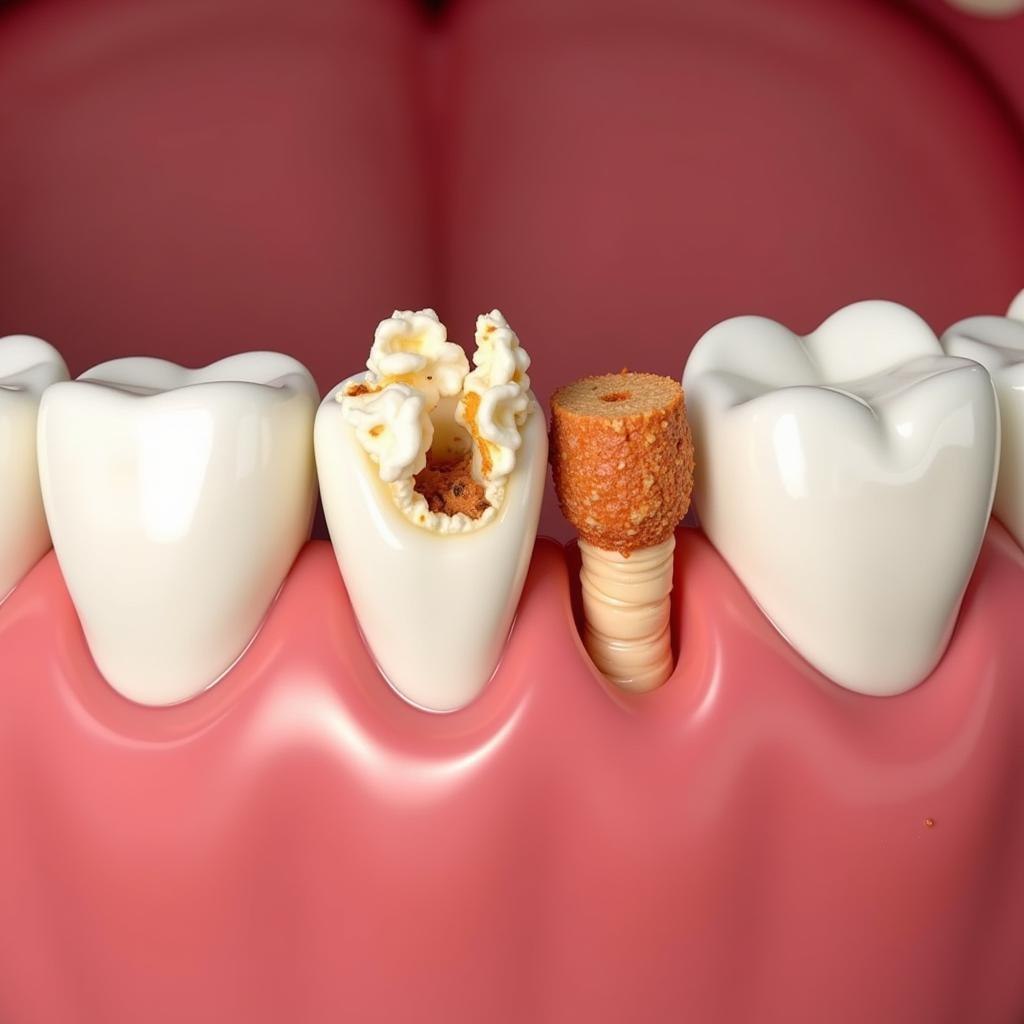That sharp, nagging pain? You’ve got a Toothache From Food Stuck In Teeth. We’ve all been there, enjoying a delicious meal only to have it interrupted by that irritating feeling of trapped food. But why does it hurt so much, and what can you do about it?
Understanding the Agony: Why Food Stuck Causes Pain
Food particles lodged between your teeth can cause more than just discomfort. They can irritate your gums, leading to inflammation and pain. If the food isn’t removed promptly, it can create a breeding ground for bacteria, potentially contributing to cavities, gum disease, and even more severe dental problems. The pressure exerted by the trapped food can also directly irritate the nerve endings in your teeth, resulting in that familiar throbbing toothache.
 Food Stuck Between Teeth Causing Pain
Food Stuck Between Teeth Causing Pain
Sometimes, the pain isn’t just from the trapped food itself. If you already have a cavity or weakened enamel, food getting stuck can exacerbate the issue. It can put pressure on the exposed dentin, causing significant pain. In other cases, the trapped food might be a symptom of a more serious dental problem, such as a cracked tooth or a failing filling. If the pain is severe or persistent, it’s essential to see a dentist.
If you frequently experience food getting stuck in your teeth, it might be a sign of other underlying issues. Spacing between teeth, crooked teeth, or worn-down fillings can all contribute to this problem. It’s worthwhile to discuss these possibilities with your dentist, who can recommend appropriate solutions. You might find helpful information on our page discussing food trap teeth pain.
Effective Ways to Remove Trapped Food and Relieve the Pain
So, what can you do when a piece of food stubbornly refuses to budge? Resist the urge to use sharp objects like toothpicks or pins, as these can damage your gums and teeth. Here are some safer and more effective methods:
- Rinsing: Vigorously swish warm water around in your mouth to dislodge the food. You can also try a saltwater rinse, which can help soothe irritated gums.
- Flossing: Gently guide dental floss between your teeth, curving it around each tooth to remove trapped debris. Be careful not to snap the floss, as this can injure your gums.
- Interdental brushes: These small, bristled brushes are designed to clean between teeth and are especially helpful for those with braces or wider spaces between teeth.
- Water flosser: This device uses a stream of pulsating water to flush out food particles and plaque.
After removing the food, if the pain persists, consider over-the-counter pain relievers like ibuprofen or acetaminophen. A cold compress applied to the outside of your cheek can also help reduce inflammation and alleviate pain. If you are experiencing significant pain from food stuck in your teeth, you should consider reading our article on food gets stuck in teeth and hurts.
“Persistent pain from trapped food shouldn’t be ignored,” advises Dr. Emily Carter, DDS. “It could be a sign of a more significant underlying dental issue.”
Preventing Future Food Traps
Beyond immediate relief, preventing food from getting stuck in the first place is key. Regular brushing and flossing are crucial, as they remove plaque and food debris that can attract bacteria. Regular dental checkups are also essential for identifying and addressing potential problems like cavities, gum disease, or misaligned teeth. For information about pain management, you may find our article about soft foods to eat when teeth hurt helpful.
“Preventive care is the cornerstone of good oral health,” explains Dr. Michael Davis, DMD. “Regular checkups and consistent hygiene habits can minimize the risk of food-related toothaches.” If you’re experiencing pain when food gets lodged, check out our article discussing tooth hurts when food gets stuck. For those who experience food getting stuck in their gums, we have a dedicated article on food gets stuck in gums and it hurts.
Conclusion: Don’t Let a Toothache Ruin Your Meal
Toothache from food stuck in teeth is a common but often preventable problem. By understanding the causes and adopting effective removal and prevention strategies, you can keep your smile healthy and pain-free. Remember, consistent oral hygiene and regular dental visits are your best defense against this culinary conundrum.
FAQ
- What should I do if I can’t remove the food myself? See a dentist.
- Can food stuck in my teeth cause an infection? Yes, if left untreated.
- Is it normal for my gums to bleed when flossing? Occasional bleeding is normal, but persistent bleeding should be addressed by a dentist.
- How often should I floss? Daily.
- Can braces make it easier for food to get stuck? Yes.
- Should I avoid certain foods if I have a tendency to get food stuck in my teeth? Consider avoiding sticky or fibrous foods.
- Can a chipped tooth cause food to get trapped more easily? Yes.
Common Scenarios:
- Scenario 1: You’re at a restaurant and a piece of steak gets wedged between your teeth. Excuse yourself and try rinsing with water or discreetly using floss in the restroom.
- Scenario 2: You wake up with a throbbing toothache caused by a popcorn kernel lodged from the night before. Try flossing or using an interdental brush. If the pain persists, see a dentist.
Further Reading
For more information on related topics, explore our articles on maintaining good oral hygiene and managing dental pain.
Contact Us
When you need support please contact Phone Number: 02437655121, Email: minacones@gmail.com Or visit us at: 3PGH+8R9, ĐT70A, thôn Trung, Bắc Từ Liêm, Hà Nội, Việt Nam. We have a 24/7 customer service team.